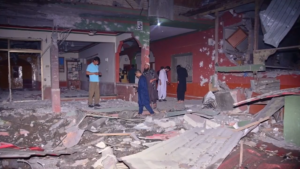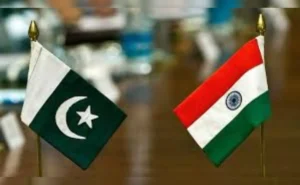Missile Use Claims Between India and Pakistan Spark Global Concern

MORE : https://newsorgames.com/
Tensions between India and Pakistan have once again flared up, sending ripples of concern across the international community. Recent claims of missile use, followed by retaliatory responses, have raised fears of a broader conflict between the two nuclear-armed neighbors.
Allegations Ignite Tensions

MORE : https://newsorgames.com/
This is the moment few would have wanted to see happening in the subcontinent.
Nuclear-armed India and Pakistan are now firing missiles at each other.
It’s a dangerous one in the ongoing military escalation by both countries.
The Pakistani military says it has destroyed an Indian airbase, airfield and a missile storage unit in India. If it’s true, that’s a massive provocation. Islamabad said it was in response to India’s missile strikes, including one close to the capital Islamabad. There has been no confirmation yet from the Indian side on Pakistan’s version of events.
After days of drone warfare, the two countries appear to have been fallen into an unknown, rather troubling territory.
The scale and intensity of the current skirmishes is the worst in three decades. The nature of the damage suffered by both sides will determine the next course of action in both capitals.
The international community must be worried at this point. With passions running high on both sides, it’s anybody’s guess on how far the escalation will be ratcheted up.
The latest escalation began when Pakistan accused India of launching a missile across the border into its territory, allegedly targeting a military installation. According to Pakistani military officials, the projectile caused limited structural damage but resulted in heightened military alertness across several provinces.
India, on the other hand, has denied any aggressive military action, calling the claims “factually incorrect and politically motivated.” The Indian Ministry of Defence insisted that no official operation involving missile deployment was authorized or executed, suggesting either a misidentification or a potential internal malfunction.
Pakistan’s Response: A Show of Strength (bunyan ul maroos)

MORE : https://newsorgames.com/
Bunyan ul Maroos?
So far, Pakistan has been attacking India using Turkish drones but Indian Air Defence Systems have been successfully neutralising them all. On the other hand, Indian drones and missiles have successfully made ground hits in Pakistan, causing widespread humiliation for the Pakistani army. In a face-saving move, the Pakistan army launched Operation Bunyan ul Maroos, meaning ‘unbreakable wall’ to fire its long-range missiles at India. Pakistan tried to hit key Indian cities using the Fatah and Abadali missiles so that it could hold the moral high ground in front of its citizens, but failed miserably as these missiles have been intercepted and neutralised.
In what appears to be a direct response, Pakistan conducted a limited but strategic retaliatory strike near the Line of Control (LoC). The strike targeted what Pakistan claims were Indian forward operating bases allegedly responsible for the initial incident. Pakistani officials stated that the response was “measured and proportionate,” aimed at sending a clear message without escalating the conflict unnecessarily.
However, India quickly condemned the retaliatory move, calling it an “unprovoked violation of ceasefire agreements” and warning that further aggression would be met with firm military resolve.
International Reaction: A Call for Restraint
In light of the growing hostilities, several international actors—including the United States, China, and the United Nations—have urged both sides to exercise maximum restraint. A UN spokesperson expressed “deep concern” over the exchange and called for immediate dialogue to prevent further deterioration.
Meanwhile, regional allies have begun behind-the-scenes diplomacy, encouraging de-escalation to avoid a repeat of the 2019 Pulwama-Balakot crisis, which brought the two nations to the brink of war.
Historical Context: A Fragile Peace
India and Pakistan have a long and troubled history, particularly over the Kashmir region. Despite numerous ceasefire agreements, skirmishes and violations are not uncommon. However, the use—or even the allegation of use—of missile systems represents a serious escalation beyond conventional border clashes.
The introduction of high-powered weaponry into the discourse raises the stakes exponentially, especially given the nuclear capabilities of both nations. Analysts warn that even a small miscalculation or misunderstanding could have devastating consequences.
What Comes Next?
While diplomatic channels remain open, military movements along the border suggest both nations are preparing for the possibility of further engagement. India has increased surveillance and mobilized additional forces, while Pakistan has placed air defense systems on heightened alert.
Both governments are facing increasing domestic pressure—India from nationalist factions demanding a show of strength, and Pakistan from military and political leaders keen to project resilience.
Conclusion: The World Watches Closely
As the situation unfolds, the international community remains on edge. The potential for escalation is real, and the consequences could be catastrophic not only for South Asia but for global stability.
Dialogue, transparency, and de-escalation must be prioritized. With so much at stake, both India and Pakistan stand at a crossroads—one leading to continued confrontation, the other to cautious diplomacy.
Would you like this turned into a press

Leave a Reply